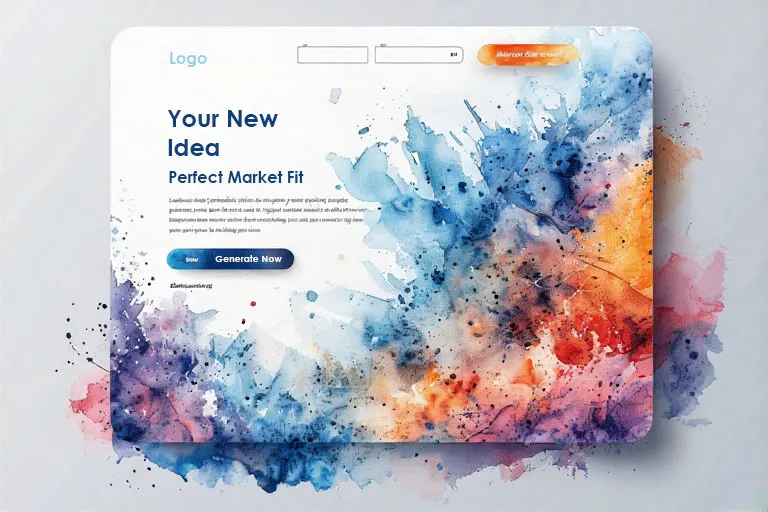Introduction: Why You Need a SaaS Idea Generator in 2025
In 2025, SaaS continues to dominate as one of the most profitable, scalable business models for solopreneurs, startups, and enterprises. But while the technology to build software has never been more accessible, the real challenge lies in coming up with the right idea... one that's validated, solves a real problem, and has demand.
That’s where a saas idea generator becomes invaluable. Whether in the form of AI tools, strategic frameworks, or curated templates, these generators offer a faster, smarter way to brainstorm potential startup ideas, reduce ideation time, and spark real business models.
This article breaks down 25 powerful SaaS idea generation strategies... from niche research and user behavior analysis to automation trends and validation methods... to help you uncover your next great SaaS opportunity.
🔢 Top 25 SaaS Idea Generator Strategies That Actually Work
1. Use a SaaS Idea Generator with Industry Inputs
One of the most efficient ways to spark SaaS ideas is by using a generator that allows industry-specific inputs. Whether you're targeting real estate, healthcare, education, or content creators, a saas idea generator with niche filters can instantly give you problem-solving concepts tailored to that vertical.
For example, inputting “freelance writers” might generate:
-
A tool to manage client deadlines and pitch history
-
An AI-based content brief generator
-
Subscription invoice tracking dashboard
This saves you hours of manual brainstorming and aligns your ideas with real-world challenges.
2. Apply the Problem-Solution Fit Framework
This classic framework begins with the question:
“What painful, recurring problem exists in this space?”
Your goal is to find problems that are:
-
Frequently experienced
-
Costly or time-consuming
-
Under-served by existing solutions
Once identified, plug the problem into a saas idea generator to explore software-based solutions. For instance, if fitness coaches struggle to monitor client habits, a problem-solution match might look like:
-
Problem: Clients don’t stay accountable between sessions
-
Solution: A mobile app that tracks progress and sends reminders
3. Explore Micro-SaaS Niches
Micro-SaaS is the art of building hyper-focused, single-feature SaaS tools. These often cater to small groups and generate revenue with minimal overhead.
Popular micro-SaaS examples include:
-
Instagram bio-link managers
-
Client review request automators
-
AI subject line testers for newsletters
Use a saas idea generator that specializes in micro-niches. These tools often combine trend data with job titles to suggest lean ideas ideal for bootstrapping.
4. Turn Daily Workflows into SaaS Features

Every profession has tasks they repeat daily. Lawyers track billable hours, marketers create reports, coaches follow up with clients. These repetitive processes are SaaS gold.
Start by mapping out a professional’s day:
-
Identify where time is lost or workflows break
-
Use a saas idea generator to convert that step into an app feature
-
Build a tool that simplifies or automates the task
This approach is user-centric and results in practical, high-demand ideas.
5. Prompt ChatGPT for Startup Ideas and Expand
Generative AI platforms like ChatGPT are useful for initial brainstorming. You can prompt:
“Generate 10 SaaS ideas for yoga instructors with limited tech skills.”
Then, take those ideas and enter them into a structured saas idea generator, which can:
-
Suggest feature sets
-
Estimate market demand
-
Recommend monetization models
Combining open AI and structured tools increases idea quality and saves iteration time.
6. Validate with Landing Pages and Waitlists
Idea validation is just as important as idea generation. A saas idea generator helps spark the idea, but you must test interest before you build.
Here’s how:
-
Build a one-page site using Carrd, Framer, or Typedream
-
Add a waitlist (via Mailchimp, ConvertKit, or Beehiv)
-
Share in online communities or run €49/day Facebook ads
Even 30–50 email signups show market demand. If no one signs up... great. You saved months of development.
7. Use the Painkiller vs. Vitamin Prioritization
A painkiller solves urgent, painful problems. A vitamin enhances long-term health or convenience.
Use this strategy to rank ideas by market urgency:
-
Painkiller: A tool that automates financial reports for accountants
-
Vitamin: A visualization dashboard for meditation streaks
SaaS idea generators with urgency scoring can help filter high-priority concepts that people are more likely to pay for today.
8. Explore Reddit, IndieHackers, and Twitter for Idea Seeds

Online communities are treasure troves for SaaS ideas. Here’s how to extract them:
-
Search for complaints like “I wish there was a tool for X”
-
Identify recurring tasks or frustrations
-
Feed them into a saas idea generator as “pain points” to convert into product ideas
These platforms reflect real-world problems from real users... exactly what your product should aim to solve.
9. Transform Spreadsheets into Full Apps
Spreadsheets are the ultimate MVP for non-technical users. If someone uses Google Sheets to manage something, that’s a SaaS opportunity.
Examples:
-
Gym owners tracking class attendance
-
Freelancers logging income by client
-
HR teams calculating retention stats
Modern saas idea generators can help turn these use cases into dedicated software tools by identifying features like form inputs, automations, and dashboards.
10. Use MVP-Mapping SaaS Tools to Structure Your First Build
Once you have a solid idea, the next step is outlining your MVP (Minimum Viable Product). Use platforms that help you map:
-
Core user actions
-
Critical features
-
Monetization options
-
Competitive gaps
This creates clarity before development starts. Several saas idea generator platforms now include integrated MVP templates to speed up execution.
11. Apply the Jobs to Be Done (JTBD) Framework
The JTBD framework focuses on the “job” users are hiring a product to do, rather than just its features.
Instead of asking:
❌ “What does the user want?”
Ask:
✅ “What job is the user trying to get done?”
For example:
-
A business coach doesn’t want another calendar app... they want to reduce no-show rates
-
A YouTuber doesn’t want editing software... they want to publish videos faster and grow their audience
Enter these jobs into a saas idea generator to uncover tools that align with these specific outcomes. Many modern generators even allow you to enter user goals as prompts to generate more relevant, solution-oriented ideas.
12. Build SaaS for the Creator Economy
The creator economy is booming. From YouTubers and bloggers to Instagram influencers and podcasters, these digital professionals need scalable tools to manage their workflows, income, and audience.
Common pain points include:
-
Managing sponsorship deals
-
Generating captions and content outlines
-
Collecting payments across platforms
Feed these problems into a saas idea generator, and you’ll often discover niche solutions such as:
-
A CRM for influencers
-
A branded media kit generator
-
A platform to manage affiliate payouts
These tools don’t need to be complex... they just need to solve a clear pain point.
13. Explore Niche Industries with Untapped Needs

Some of the best SaaS ideas come from industries that are:
-
Highly manual
-
Tech-averse
-
Recently digitizing
Examples:
-
Legal tech for solo lawyers
-
Back-office SaaS for landscaping companies
-
Compliance software for daycare centers
A robust saas idea generator can help scan niche industries, filter by business type, and match software ideas with underserved markets.
Bonus Tip: Combine this strategy with trend tools like Exploding Topics or Google Trends to validate demand.
14. Join and Listen to Build-in-Public Communities
Communities like Indie Hackers, Product Hunt, X/Twitter #buildinpublic, and Hacker News are excellent spaces to:
-
Spot trending pain points
-
Get feedback on early SaaS ideas
-
Validate assumptions in real-time
Many successful founders now use a saas idea generator to craft their initial concept, then refine it publicly with feedback from these communities.
Example:
A user-generated an idea for a "client feedback dashboard" for freelancers, posted it on Indie Hackers, and got 100+ responses... half of which requested early access.
15. Improve Outdated SaaS Tools
There are hundreds of SaaS tools that launched 5+ years ago and haven’t kept up with user expectations. Many still have:
-
Clunky interfaces
-
Limited integrations
-
Outdated onboarding UX
Steps to use this strategy:
-
Search review platforms like G2 or Capterra for “low-rated” tools
-
Read user complaints and wishlists
-
Feed this into your saas idea generator as “product gaps”
You’ll get fresh, modernized ideas that solve the same problems... just better.
16. Build SaaS for Solopreneurs
The one-person business is thriving. Writers, designers, consultants, and virtual assistants are building six-figure businesses... often with outdated workflows.
Popular needs include:
-
Scheduling tools
-
Personal CRMs
-
Proposal and invoice builders
-
Branded onboarding portals
Use a saas idea generator that focuses on solopreneurs and indie professionals. These users often need lightweight, affordable, and intuitive tools they can set up in minutes.
17. Consolidate Disconnected Tools Into One Platform
Users often juggle multiple tools to get one job done:
-
Calendars + invoicing apps + CRMs
-
Form builders + database managers
-
Email tools + file-sharing apps
If people are switching between 3–5 platforms daily, that’s a sign of fragmentation. A good saas idea generator can help spot these multi-tool dependencies and suggest all-in-one platforms.
This works especially well in:
-
Remote team management
-
Client services
-
Online learning
18. Build SaaS Extensions or Plug-ins Instead of Platforms

You don’t always need to create a full product. Building extensions or plug-ins can be just as profitable... and easier to ship.
Examples:
-
Chrome extensions for Gmail productivity
-
Slack bots for meeting summaries
-
Zapier connectors for small platforms
If you’re targeting developers, marketers, or busy teams, plug-ins often provide high utility with minimal setup. Modern saas idea generators may even have plug-in modes or filters for generating lightweight ideas.
19. Generate Domain Name Ideas Automatically
Coming up with a good name can stall even the best startup ideas. Most saas idea generators today help brainstorm naming ideas using combinations of:
-
Action-based prefixes (Try, Go, Use)
-
Short, brandable nouns (loop, deck, kit)
-
Trending extensions (.io, .app, .ai)
Examples:
-
TryClientLoop.com
-
UseDeckly.app
-
PayKit.ai
While these tools don’t always check availability, they inspire brand identity early and save brainstorming time.
20. Focus on “Boring” But Profitable Industries
Some of the highest-earning SaaS tools solve problems in unsexy industries:
-
Janitorial services
-
Trucking logistics
-
Tax resolution
-
Elder care scheduling
These markets are often ignored... but users are desperate for efficiency and willing to pay for it.
Use a saas idea generator with filters like “low competition” or “local services” to uncover ideas in these fields. Bonus: there’s usually less noise, easier marketing, and faster validation cycles.
21. Use Google Autocomplete for Real Search-Based Idea Seeds
One of the simplest but most effective strategies is to let Google autocomplete your ideation process. Start typing in phrases like:
-
“How do real estate agents manage…”
-
“Best tools for freelancers to…”
-
“I need help tracking my…”
Autocomplete shows you what real people are searching for right now. These search suggestions represent actual user intent... perfect for feeding into your saas idea generator as raw inputs.
You can also pair this technique with tools like:
-
Ubersuggest
These enhance idea generation by expanding user queries into clusters of problems and subtopics.
22. Monitor Trends Using Exploding Topics and Product Hunt

If you want to spot emerging SaaS opportunities before they go mainstream, monitor trend platforms like:
For example, if "AI voice assistants for teams" is trending on Exploding Topics, enter that into your saas idea generator and let it suggest:
-
Daily stand-up bots
-
Meeting summarizers
-
Voice-controlled CRMs
Trend data + ideation tools = the future of startup discovery.
23. Interview Professionals and Freelancers in Your Target Market
No tool is more powerful than direct feedback from potential users. After generating a SaaS idea, validate it by reaching out to:
-
Freelancers on Upwork or Fiverr
-
Professionals in LinkedIn groups
-
Reddit users in relevant subs (e.g., r/Consulting, r/DesignJobs)
Ask:
-
“Do you face this problem?”
-
“Would this tool help?”
-
“What’s missing in your current process?”
Pair these insights with your saas idea generator to refine your concepts and add real-world depth.
24. Use the “10x Better” Framework to Differentiate
Even if a SaaS product already exists, there’s often room for something 10x better... faster, more affordable, more enjoyable to use.
Ask:
-
Can this be 10x easier to onboard?
-
Can this run 10x faster than current tools?
-
Can this be 10x cheaper using automation?
A solid saas idea generator helps uncover not only the base idea but also the gaps you can exploit to make your solution the best in class.
25. Build in Public With a Transparent Roadmap
Modern SaaS founders are building their tools in the open. Why? Because:
-
It builds trust
-
It attracts early adopters
-
It keeps you focused
After using your saas idea generator to find a validated idea, start sharing:
-
Weekly updates on Twitter or LinkedIn
-
User interviews and feature polls
-
Screenshots of your MVP development
Communities like Indie Hackers, Makerlog, and Buildspace are perfect for this. They offer support and distribution as you bring your SaaS idea to life.
🧠 Featured SaaS Idea Generator: SaaSThink
If you’re looking for a tool that simplifies idea generation, validation, and MVP planning, check out SaaSThink.
SaaSThink is an intuitive, AI-powered saas idea generator that helps founders:
-
Generate startup ideas based on industry + pain point
-
Discover naming suggestions for brandable domains
-
Get MVP feature outlines and monetization guidance
-
Focus on validated, low-competition ideas that solve real problems
Whether you’re a beginner exploring options or an experienced builder ready to launch your next tool, SaaSThink bridges the gap between inspiration and execution.
🔗 Learn more at: SaaSThink
❓ Frequently Asked Questions
1. What is a saas idea generator?
A saas idea generator is a tool or strategy designed to help entrepreneurs create new software-as-a-service business ideas based on user pain points, industry trends, and tech capabilities.
2. How accurate are the ideas from these tools?
They’re as accurate as the data they pull from. Tools that combine AI with trend analysis or user research (like domain-specific prompts or Reddit scraping) generate more grounded ideas.
3. Can I build a successful startup using only a saas idea generator?
Yes, many successful SaaS businesses started as generated concepts. But execution, validation, and iteration are still crucial.
4. How many times should I use one?
Use it frequently. Great ideas often come from volume... generate 50 ideas, shortlist 10, validate 3, and build 1.
5. Are free idea generators worth it?
Absolutely. Many free versions provide real value. Paid options tend to include market scoring, competitor analysis, or MVP planners.
6. How do I know if my SaaS idea is “good”?
If it solves a painful problem, people are willing to pay, and early users are engaged... it’s good. Test with pre-sales, waitlists, or interviews to confirm.
✅ Conclusion: Take the First Step with a Saas Idea Generator
The hardest part of starting a SaaS business isn’t coding.. it’s knowing what to build.
By using a saas idea generator, applying proven frameworks, and validating your assumptions early, you can shortcut years of confusion and wasted effort.
From tapping into niche industries and freelancer pain points to leveraging AI prompts and public feedback, these 25 strategies are built to help you turn insight into innovation.
Now the only question is: what will you build next?


